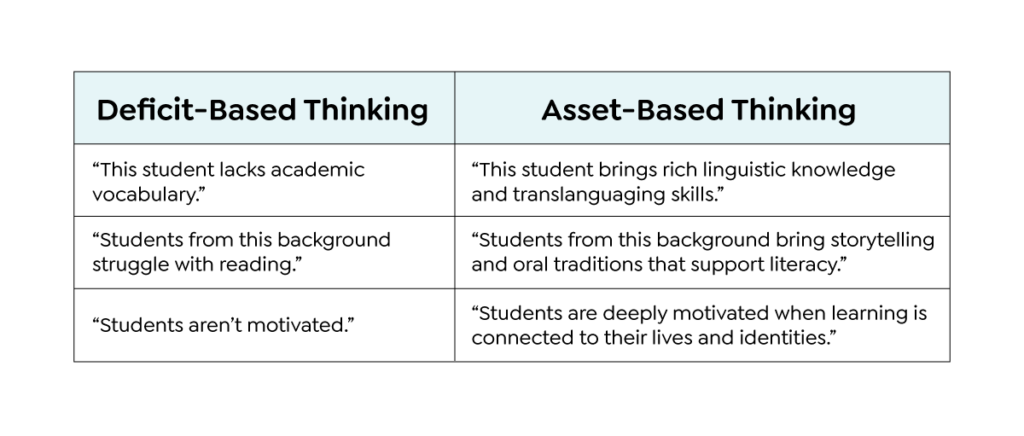Every student walks into the classroom with a story—a lived experience shaped by their culture, community, and personal journey. This story forms the foundation of their learner identity, which is deeply intertwined with their cultural identity. When schools fail to honor students’ cultural assets, their sense of belonging and self-efficacy suffers. However, when we recognize and nurture learner identity through asset-based pedagogies, we create the conditions for learner agency to thrive.
Learner identity refers to how students see themselves as learners, including their beliefs about their abilities, intelligence, and place in the academic world. This identity is not developed in isolation—it is shaped by students’ cultural backgrounds, languages, traditions, and lived experiences. Research shows that when students’ cultural identities are valued in learning spaces, they are more engaged, motivated, and resilient (Ladson-Billings, 1995; Paris & Alim, 2017).
At the intersection of learner identity, agency, and academic success, we find John Hattie’s research on high-impact instructional strategies. His work in Visible Learning (2009) provides a compelling case for why asset-based pedagogies are not just equitable but essential for learning. This blog explores how learner identity, asset-based teaching, and Hattie’s research align to create powerful learning environments where all students thrive.
Defining Learner Agency: Identity in Action
Learner agency is the ability of students to take ownership of their learning, set goals, reflect on their progress, and act with autonomy and purpose (Bloomberg & Pitchford, 2023). Agency is not just about academic independence but about students seeing themselves as capable, valued, and powerful learners.
But learner agency cannot exist without a strong, affirmed cultural identity. Cultural identity refers to the deeply held sense of belonging to a particular group, shaped by shared traditions, language, values, beliefs, customs, and historical experiences. It is the lens through which individuals understand themselves and navigate the world, influencing how they communicate, interpret knowledge, and engage in learning. Cultural identity is not static—it evolves as individuals interact with different environments, communities, and experiences. At its core, cultural identity is both personal and collective, rooted in one’s ancestry, family history, and societal affiliations, while also being shaped by social, political, and historical contexts (Hall, 1996).
If students internalize messages that their culture, language, or background is a barrier to learning, they may disengage, lack motivation, or resist participation. Conversely, when educators center learner identity as an asset, students are more likely to:
- Take intellectual risks
- Participate in collaborative learning
- Advocate for themselves
- See their voices and experiences as meaningful
In short, a student’s cultural identity fuels their learner identity and their learner identity fuels learner agency. Conversely, when schools dismiss or marginalize cultural identity, students may struggle with engagement and self-efficacy. Research on culturally relevant pedagogy (Ladson-Billings, 1995), funds of knowledge (González et al., 2005), and culturally sustaining pedagogies (Paris & Alim, 2017) all emphasize that validating cultural identity in schools is key to fostering student agency, resilience, and academic success.
Implementing asset-based pedagogies ensures that all students—especially those from historically marginalized backgrounds—see themselves as competent, knowledgeable, and worthy contributors to the learning process.
The Case for Asset-Based Pedagogies
Asset-based pedagogies are instructional approaches that center students’ cultural backgrounds, linguistic repertoires and lived experiences as strengths rather than deficits. Unlike traditional deficit-based models that focus on what students lack—such as English proficiency, academic vocabulary, or prior exposure to dominant educational norms—asset-based pedagogies recognize that all students bring valuable knowledge, skills, and ways of knowing into the classroom. These approaches affirm learner identity, ensuring that students see themselves as capable, valued, and integral to the learning process. Asset-based pedagogies emphasize how schools can build on students’ cultural wealth rather than erase it. When educators leverage these strengths, students experience higher engagement, greater self-efficacy, and deeper ownership of their learning—core tenets of learner agency.
Key Research and Connections to Hattie’s Work
Several scholars have significantly shaped the discourse on asset-based pedagogies. Gloria Ladson-Billings’ (1995) work on culturally relevant pedagogy emphasizes the importance of connecting academic content to students’ cultural contexts while fostering critical consciousness. Luis Moll’s research on funds of knowledge (González et al., 2005) highlights the wealth of intellectual and cultural resources that families and communities contribute to students’ learning. More recently, Django Paris and H. Samy Alim (2017) introduced culturally sustaining pedagogies, advocating for education that not only acknowledges cultural diversity but actively sustains and nurtures students’ cultural identities. Tara Yosso (2005) extended this conversation with her theory of community cultural wealth, identifying aspirational, linguistic, familial, social, navigational, and resistant capital as key assets that students bring to school. These frameworks closely align with John Hattie’s research on high-impact instructional strategies. For example, Hattie’s emphasis on collective teacher efficacy (1.57 effect size) underscores the power of educators believing in all students’ potential—a fundamental principle of asset-based pedagogy. Similarly, Hattie’s findings on student expectations (1.33 effect size) affirm that when students see their cultural knowledge reflected and valued in the classroom, they set higher expectations for themselves, reinforcing their learner identity and agency.
An asset-based approach requires a fundamental shift in how we view students and learning:

This shift transforms student engagement, self-efficacy, and agency, creating an inclusive learning environment where all students see themselves as capable learners.
 Making Impact with Agency via Asset-Based Pedagogies
Making Impact with Agency via Asset-Based Pedagogies
John Hattie’s Visible Learning identifies instructional strategies that have the greatest impact on student achievement. Many of his most powerful influences reinforce the importance of learner identity and agency in academic success.
1. Collective Teacher Efficacy (Effect Size = 1.57)
Hattie identifies collective teacher efficacy as the highest-impact influence on student achievement. This refers to the shared belief among educators that they can positively impact students’ learning—a belief that must extend to all students, including those who have been historically marginalized.
Learner Identity Connection:
When educators adopt asset-based mindsets, they reject deficit narratives and affirm students’ cultural and linguistic strengths. This, in turn, reinforces positive learner identity.
Rethinking Expectations:
Instead of: “This student struggles with academic English.”
We say: “This student is a skilled multilingual communicator who is expanding their academic vocabulary.”
When students sense that teachers believe in their abilities and cultural knowledge, they are more likely to develop a strong learner identity and take ownership of their success.
2. Student Expectations of Themselves (Effect Size = 1.33)
One of Hattie’s most powerful findings is that students’ own expectations for their success significantly shape their academic outcomes. If students see themselves as capable learners, they engage more deeply, persist through challenges, and take greater initiative in their learning.
Learner Identity Connection:
If students’ cultural backgrounds and ways of knowing are invalidated in school, they may internalize low expectations. Asset-based pedagogy disrupts this cycle by:
- Celebrating students’ funds of knowledge (González et al., 2005)
- Encouraging students to set goals based on their own strengths and interests
- Using culturally responsive texts, problems, and projects
Rethinking Expectations:
Instead of: “Students from this neighborhood don’t perform well on standardized tests.”
We say: “These students bring rich problem-solving skills from their lived experiences, and we will build on those strengths in meaningful ways.”
By nurturing a positive learner identity, we help students set higher expectations for themselves, which research shows leads to higher achievement.
3. Student-Centered Feedback (Effect Size = 0.73)
Hattie’s research highlights the power of timely, specific, and student-centered feedback. But feedback is only effective when students trust their learning environment and see their identities reflected in the assessment process.
Learner Identity Connection:
Asset-based pedagogy reframes feedback as a dialogue that affirms identity rather than a correction of perceived deficits. Effective feedback:
- Affirms what students do well before addressing areas for growth
- Uses students’ own cultural frameworks and experiences to make learning meaningful
- Encourages self-reflection and peer feedback, strengthening learner agency
For example, when assessing a multilingual learner’s writing, feedback should highlight the richness of their ideas and language before addressing grammar conventions. This approach ensures that students see their full linguistic and cultural repertoire as a strength, not a deficit (García & Wei, 2014).
4. Metacognitive Strategies & Self-Assessment (Effect Size = 0.55 – 0.75)
Hattie emphasizes the importance of metacognitive strategies, such as self-questioning, goal-setting, and reflection, to help students regulate their own learning.
Learner Identity Connection:
Metacognition is most effective when students see their ways of thinking, knowing, and problem-solving as valid.
- Students from oral storytelling traditions might reflect best through verbal self-assessment.
- Students from collectivist cultures might prefer peer-based reflection over individual journaling.
- Multilingual students might benefit from translanguaging as they think through their learning process.
Rethinking Pedagogy:
Instead of: “Reflect in a standard written journal.”
We say: “Use video, spoken word, or a multilingual reflection to track your thinking.”
When we honor learner identity in metacognition, students see their own ways of thinking as valuable, increasing their sense of agency.
Centering Learner Identity to Unlock Agency
Hattie’s research confirms what asset-based educators have long known: When students’ identities are validated and their cultural assets are recognized, their academic outcomes soar. By affirming learner identity, we create the conditions for agency to flourish. Students set higher expectations for themselves, engage deeply in learning, and develop the skills to navigate their educational journeys with confidence.
This work requires a paradigm shift:
- From “fixing students” to amplifying their strengths
- From deficit-based labels to affirming learner identity
- From passive learning to active agency
The goal of education is not to mold students into a predefined standard of success but to empower them to define success on their own terms—grounded in their identities, cultures, and voices.
Learn more about how to advance learner agency by joining our Impact Team Cadre!
References
- Bloomberg, P. J., & Pitchford, B. (2023). Leading Impact Teams: Building a Culture of Efficacy and Agency. Mimi & Todd Press.
- Bloomberg, P., Vandas, K., Twyman, I., Dukes, V., Carrillo Fairchild, R., Hamilton, C., & Wells, I. (2022). Amplify learner voice through culturally responsive and sustaining assessment. Mimi and Todd Press.
- García, O., & Wei, L. (2014). Translanguaging: Language, Bilingualism and Education. Palgrave Macmillan.
- González, N., Moll, L. C., & Amanti, C. (2005). Funds of Knowledge: Theorizing Practices in Households, Communities, and Classrooms. Routledge.
- Hattie, J. (2009). Visible Learning: A Synthesis of Over 800 Meta-Analyses Relating to Achievement. Routledge.
- Hattie, J. (2018). Visible Learning: Feedback. Routledge.
- Ladson-Billings, G. (1995). Toward a theory of culturally relevant pedagogy. American Educational Research Journal, 32(3), 465-491.
- Paris, D., & Alim, H. S. (2017). Culturally Sustaining Pedagogies: Teaching and Learning for Justice in a Changing World. Teachers College Press.
- Rogoff, B. (2003). The Cultural Nature of Human Development. Oxford University Press.
- Yosso, T. J. (2005). Whose culture has capital? A critical race theory discussion of community cultural wealth. Race Ethnicity and Education, 8(1), 69-91.



